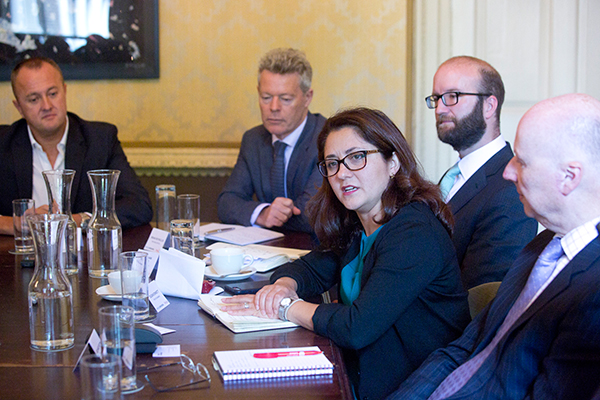Roundtable: shaping the ‘part rent, part buy’ market
Investors and housing professionals pick up where the Housing White Paper left off, focusing on ways to increase supply of shared ownership. David Blackman reports. Photography by Belinda Lawley
Sponsored by

One year on from a roundtable addressing the myths and merits of what could be the ‘fourth mainstream tenure’, shared ownership specialist Heylo and Social Housing brought together investors and housing professionals to explore ways to accelerate supply.
Ahead of communities secretary Sajid Javid’s announcement of a “fundamental rethink” of social housing, the panel explored the call in the Housing White Paper for funders, providers and local authorities to “invest more widely in housing, including shared ownership”.
Government focus
It has been a tumultuous few months since the Housing White Paper was published.
Brian Reynolds, programme director of the Local Government Association’s One Public Estate initiative, views the white paper as a better and more coherent piece of policy than the Housing and Planning Act.
But referring to a recent meeting with the permanent secretary at the Department for Communities and Local Government, Mr Reynolds says the government has clearly had other priorities.
He says: “Melanie Dawes still spends most of her working day dealing with Grenfell fallout, so it’s very difficult to see that there is the capacity for any policy change in this area.”
Jonathan Shaw, head of client portfolio management at hedge fund Man Group, describes the tone of the white paper as “very positive”.
He says: “Knowing there is support from local and national government is very encouraging, because you know there are lots of risks”.
Jonathan Clarke, a partner at treasury specialist Centrus Advisors, expresses scepticism that the white paper will lead to much change due to the wider pressures on the minority Conservative government.
Richard Petty, lead director in the residential advisory division of JLL, adds that the measures outlined do not match the government’s ambition to increase housing output to 200,000 new homes per annum.
Speaking about the change in housing minister since the general election, Mr Petty says: “It’s not as politically important as it should be.”
However, Susan Emmett, head of housing and urban regeneration at thinktank Policy Exchange, says that former housing minister Gavin Barwell’s appointment as the prime minister’s chief of staff means the sector has a high-level advocate within government.
“We don’t have a housing minister at the cabinet table, but we’ve got somebody very close to the prime minister working in Number 10 – which is hugely encouraging.”
Ms Emmett says the first test of the government’s resolve on implementing the white paper’s supply ambitions will be how it takes forward its proposals to reform the objectively assessed need system of calculating local housing targets.
“The idea is to get local authorities to have more ambitious housing targets, which meet needs rather than what they are comfortable with,” she says.
“The election resulted in a very fragile Conservative majority, with all the difficulties that brings with passing legislation, but it has really served to concentrate the government’s mind on issues such as housing because of the demographics of the vote. They lost a lot of votes among young people, who are priced out of homeownership.”
She points to a YouGov poll of 18 to 24-year-olds, which showed that only four per cent trust the Conservatives on housing, compared to 44 per cent for Labour.
Addressing need
One way to address the first-time buyer age group in recent years has been to promote shared ownership. But despite support for this policy, there are often questions from some investors around its financing.
“Debt investors don’t love shared ownership,” says Mr Clarke, who points to the contrast with the plentiful access to cheap money enjoyed by mainstream social and affordable rented housing.
JLL’s Mr Petty says the sale element of shared ownership is part of the challenge: “Investors want long-term index-linked income. If shared ownership works as it is intended, it will get taken away from you part-way through, and you will get a capital receipt rather than income. A lot of investors don’t want that.”
He says very little shared ownership has been transacted, which makes it more difficult to establish values.
He adds that ventures like Heylo are helping to develop a market for shared ownership, but that the sector still needs to attract the interest of pension funds and other institutional investors.
The relatively undeveloped nature of what remains a sub-sector of the market is another factor, with uptake still patchy geographically.
Mr Reynolds says: “It’s popular in London because it gives access to a home you wouldn’t be able to otherwise afford.
“Registered providers like to hang onto it because it is protected from the [rent] cuts.”
Nicholas McAlpine-Lee, chief executive of Heylo, agrees: “[Housing associations] are not asset sellers but asset keepers.”
Market solutions
That leaves the ball in the court of the market to innovate. The scope for delivering shared ownership on a purely commercial basis was one of the hot topics at the roundtable debate.
Mr McAlpine-Lee says: “We came to the world of affordable housing because it was an investment opportunity. We looked at risk and reward, and social good came second. You have to be realistic that that’s the way any investor will approach this: it’s a great sales feature to say it’s doing social good, but that comes at the end of the conversation.”
Martin Zdravkov, associate director at Aviva Investors, agrees: “There is no wall of money for affordable housing, private rented sector or any specialist housing product: there is a wall of money for a specific level of risk and return.
“The wall of money has no conscience, it has no feelings, it has no social objective. The notion that there is a wall of capital that will sacrifice return for the same level of risk because there is a social good is very, very small.
“It’s nice to have as a by-product of a risk and return profile, but the ethical approach can’t be the leading one unless you are targeting a very finite pool of capital.”
Trevor Castledine – who is investment director and head of credit investment at the Local Pensions Partnership Investments – signed off £300m for Heylo while in a similar role at Lancashire County Pension Fund, making him a board member of the venture.
“I can’t pursue a nice political or social agenda unless it makes money for my investors,” he says, adding that no investor would subsidise the pursuit of social goals.
But JLL’s Mr Petty says there is more of an appetite for social housing as an ethical investment.
He says: “Social housing can and should be seen as an ethical investment: there is some capital that will chase that.
“There is no particular reason why, set up correctly as an investment, shared ownership can’t be both ethical and return a decent level that is commensurate with the risks you are running.”
He cites supported housing real estate investment trusts (REITs) which have recently been launched.
Centrus’ Mr Clarke says shared ownership is “hard to do on a commercial basis”.
David Toplas, chief executive of Mill Group, adds that the key to growing the shared ownership market is to call it something different, such as “part buy, part rent”. But he says that Mill’s attempt to secure investment backing for such a product, which the company had been working on for seven years, had proved a “massive challenge”.
Mr Castledine adds that the Local Pensions Partnership’s investment in Heylo had come from its credit rather than real estate bucket.
“This is not a real estate investment, it’s an investment by a pension fund in the future cash flows they need to pay their pensions.”
Better understanding
Mervyn Jones, director at Savills, says there have been some advances in the quality of information available about the performance of shared ownership portfolios.
“People have seen they perform quite well and that they are not sub-prime lending,” he says, pointing out that shared ownership has a “very low” default rate and that investors have a number of exit routes even if this happens.
However, Mr Jones adds that loan-to-value ratios remain low for housing associations on their element of shared ownership schemes.
Mr Zdravkov says this lack of scale is one of the factors making it difficult for large pension funds to invest in shared ownership.
Mr Clarke agrees: “You will never get a fund manager interested in something for £1m or £2m. You’ve got to get over that with real transparency and data.”
However, Man’s Mr Shaw says the stake that occupiers have in their properties is a plus point for investors in contrast to rented housing, where tenants have less interest in properly looking after their homes.
“The challenges are where there are misalignments of interest with the tenant. The wonderful thing about shared ownership is that the tenure is almost more of a partnership than the landlord-tenant relationship.”
He says that this alignment of interest creates scope for lower vacancy and bad debt rates.
Mr Toplas says investors have not really woken up to this alignment of interest offered by shared ownership.
“The value in pure financial risk management terms of having people in your property in shared ownership who have an equity stake in the ownership of their property is massively undervalued,” he says, pointing out that landlords could also make big savings by transferring responsibility for minor repairs.
“We know from a landlord’s point of view that dealing with dripping taps and small bits of maintenance is incredibly inefficient and expensive.”
But JLL’s Mr Petty questions whether shared ownership really is the partnership described by Mr Shaw: “Under a shared ownership lease you have passed all the repairs and maintenance obligations down to the tenant so you can sit back, take the staircasing, the rent and you have the investment return.
“It’s not a partnership in the sense that you have offloaded all the things that would worry you as a property owner.”
Countering this, Heylo’s Mr McAlpine-Lee points out that occupiers in shared ownership would benefit even if they shouldered these extra responsibilities.
“The trade-off is that the landlord doesn’t kick you out when they feel like it, and you can terminate your full repairs and insurance obligations at any time by selling your property. If you have looked after it you will get the benefit.”
Mr Castledine says that tenants enjoy a much more affordable rent than they would otherwise be able to achieve, which in turn means that landlords have to accept a lower return.
“There is a transfer of risk but also a transfer of return to the tenant,” he adds.
Mr McAlpine-Lee says that if house price inflation continues on the historic trajectory of Retail Price Index plus one per cent per annum, this ratio would be less than two per cent within 40 years, falling further to below one per cent after 60 years.
He says shared ownership generally works out as good value for investors, asserting that the 2.75 per cent ratio between rents and landlords’ retained equity was good value compared to the one to 1.5 per cent benchmark value for index-linked gilts.
Mr Petty agrees: “From an investor point of view, 2.75 sounds pretty good.”
Owning a share
Mr Castledine adds that affordability for the end customer matters because it can ensure the investment delivers sustainable returns over the long term.
Shared ownership is cheaper than renting privately “everywhere”, according to Mr McAlpine‑Lee.
“You are buying new build, so you have 10 years of more or less no maintenance, which gives you a really good nest egg.”
And it works out as a better deal in terms of monthly payments than full owner-occupation, with the crossover point happening around the 17 to 19-year mark, he says.
“If you took exactly the same property with a [full] mortgage, it would take that period of typical Retail Price Index to reach the point where it is as expensive,” he says, adding the caveat that this calculation does not take into account any house price inflation that the owner-occupier would enjoy during this period.
For Centrus’ Mr Clarke, this factor means that shared ownership is not, ultimately, as good a deal as 100 per cent owner-occupation.
“If you had the ability to raise that mortgage you wouldn’t do shared ownership – you would buy outright. You are getting value from that because you own the whole house. We are still living in an environment where people with assets buy stuff outright.
“It is a more expensive product than outright sale,” he adds.
Aviva’s Mr Zdravkov says that from a long-term investor’s point of view it is important to ensure that shared ownership remains affordable for the occupier.
“We are investing on the premise that people can afford a product. In order to have a sustainable long-term risk-and-reward profile, people need to be able to afford it.”
And he warns that any change of policy would result in increased uncertainty, which would in turn be off-putting for investors who have other options.
“Each time there is a change of policy, the wall of money stops moving. While there is uncertainty, investors want a higher return, and the higher the return the less affordable the outcome.”
He adds: “Pension fund money is looking for long, boring, predictable, fair returns. If you want excitement, read a travel magazine.”
Attendees
Martin Zdravkov
Associate director, Aviva Investors
Graeme Moran
Portfolio and acquisitions, Heylo Housing
Richard Petty
Lead director of residential advisory, JLL
Susan Emmett
Head of housing and urban regeneration, Policy Exchange
Jonathan Clarke
Partner, Centrus Advisors
Brian Reynolds
Programme director, One Public Estate
Nicholas McAlpine-Lee
Chief executive, Heylo Housing
David Toplas
Chief executive, Mill Group
Jonathan Shaw
Head of client portfolio management, Man Group
Mervyn Jones
Director, Savills Housing Consultancy
Trevor Castledine
Investment director and head of credit investment, Local Pensions Partnership Investments
RELATED






